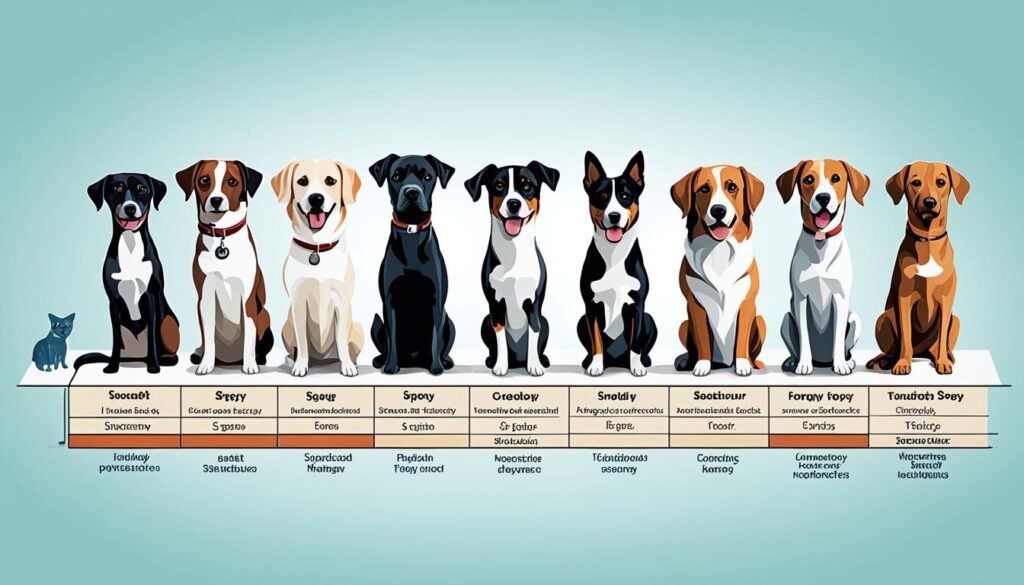Neutering and spaying dogs is a common practice in the United States, with 78% of households with dogs choosing to do so. However, new research indicates that the traditional age of four to six months may not be the most suitable time for neutering or spaying a dog. Recent studies have revealed that early neutering or spaying could potentially increase the risk of health issues like joint disorders and certain types of cancers for specific breeds. To ensure the best timing for neutering or spaying your dog, taking into account factors such as breed, size, and future medical concerns, it is essential to have a thorough discussion with a veterinarian.
Key Takeaways:
- The traditional age of four to six months may not be the best time to spay or neuter a dog.
- Early spaying or neutering may increase the risk of health conditions in certain breeds.
- Consult with a veterinarian to determine the optimal timing for spaying your dog.
- The decision should take into account the individual dog’s breed, size, and potential future medical concerns.
- Discussing the risks and benefits with a professional is essential for making an informed decision.
Understanding the Basics of Spaying and Neutering
Spaying and neutering are common medical procedures performed on dogs to control their reproductive capabilities. It involves removing the reproductive organs of female and male dogs, respectively. Spaying refers to the removal of the uterus and ovaries in female dogs, while neutering involves removing the testicles and associated structures in male dogs.
The early campaigns promoting spaying and neutering did not fully consider the impact of sex hormones on canine health. However, recent research has shed light on the importance of sex hormones in the development and overall well-being of animals.
Sex hormones play a crucial role in various aspects of a dog’s health and development, including psychological, musculoskeletal, cardiovascular, and immune system development. They contribute to the growth and maturation of the body, regulate behavior and mood, and have an impact on overall health and longevity.
It is important to understand that spaying and neutering may have both positive and negative consequences for dogs, depending on various factors such as the timing of the procedure, the individual dog’s breed, size, and potential future medical concerns.
Tailoring the Decision to Your Dog’s Breed and Size
When it comes to spaying or neutering your dog, it’s crucial to consider their breed and size. Dogs of different breeds and sizes mature at different ages, and this can have an impact on the timing of the procedure. Toy breeds, for example, tend to reach sexual maturity as early as six to nine months, while larger breeds may not mature until they are 16 to 18 months old.
This variation in maturation means that the risks associated with early spaying or neutering may differ depending on the dog’s breed and size. Larger breeds, in particular, may be more susceptible to certain health conditions if they are spayed or neutered at a young age. It’s important to be aware of these risks and make an informed decision based on your individual dog’s characteristics.
Understanding the potential health conditions that larger breeds may be prone to can help guide your decision-making process. For example, joint disorders like hip and elbow dysplasia are more common in larger breeds, and early spaying or neutering may increase the risk of developing these conditions.
In addition to joint disorders, certain cancers may also be more prevalent in larger breeds. While spaying or neutering can help reduce the risk of certain cancers in female dogs, there may be a higher risk of other cancers, such as osteosarcoma, in larger breeds that are spayed or neutered at an early age.
“Dogs of different breeds and sizes mature at different ages, and this variation in maturation means that early spaying or neutering may pose higher risks for larger breeds compared to small or toy breeds.”
Therefore, it is crucial to tailor the decision of when to spay or neuter your dog to their specific breed or breed type, sex, size, and potential future medical concerns. Consulting with a veterinarian who has experience with your dog’s breed can provide valuable insights and guidance.
Benefits of Spaying or Neutering at the Right Time
While there may be increased risks associated with early spaying or neutering for larger breeds, it’s important to remember that there are also benefits to consider. Spaying a female dog at the appropriate time can help prevent unwanted behaviors, reduce the risk of certain cancers, and eliminate the risk of heat cycles and associated behaviors. Neutering male dogs can prevent roaming, aggression, and reproductive-related health issues.
By tailoring the decision to your dog’s breed and size, you can make an informed choice that takes into account both the potential risks and benefits. Your veterinarian can provide invaluable guidance based on their professional knowledge and experience with your specific dog’s needs.

Potential Health Risks Associated with Early Spaying or Neutering in Larger Breeds
| Health Condition | Risk in Larger Breeds |
|---|---|
| Joint Disorders (e.g., hip and elbow dysplasia) | Increased risk |
| Certain Cancers (e.g., osteosarcoma) | Potentially increased risk |
The Role of the Owner in the Decision-Making Process
When it comes to deciding the optimal age for spaying or neutering a dog, the American Veterinary Medical Association (AVMA) highlights the significance of the owner’s involvement and the professional judgment of veterinarians. The AVMA, a recognized authority in veterinary medicine, stresses that determining the best timing for the procedure should be a case-by-case assessment conducted by a trusted veterinarian.
“Every dog is unique, and decisions about spaying and neutering should be made in consultation with a veterinarian, who can best determine what is appropriate for each individual animal.” – American Veterinary Medical Association
Veterinarians possess the expertise needed to evaluate various factors when considering spaying or neutering a dog. These factors may include the dog’s age, breed, size, overall health, behavior, and potential future medical concerns. Through professional judgment, veterinarians can tailor their recommendations to each dog’s specific needs.
Moreover, owners can play a crucial role by providing valuable information about their dog’s previous medical history, breed-specific characteristics, and lifestyle, contributing to an accurate assessment of the optimal timing for the procedure.
In addition to professional veterinary guidance, breeders of purebred dogs can also offer valuable insights into the ideal age for spaying or neutering. With their in-depth knowledge of specific breeds and their commitment to preserving breed characteristics, breeders can assist owners in making well-informed decisions.
A collaborative approach between the owner, veterinarian, and breeder ensures that the decision to spay or neuter is made with careful consideration and an understanding of the potential risks and benefits for the individual dog.

| Guidelines for Owner’s Involvement | Benefits |
|---|---|
| Consult with a trusted veterinarian | Ensures the decision aligns with the dog’s individual needs and characteristics |
| Provide accurate information about the dog’s medical history, breed, and lifestyle | Enables a thorough assessment of potential risks and benefits |
| Seek insights from purebred dog breeders | Access valuable breed-specific knowledge |
By actively participating in the decision-making process alongside veterinary professionals, owners can prioritize their dog’s well-being and make informed choices regarding the timing of spaying or neutering.
Factors to Consider for Spaying Female Dogs
When deciding on the optimal timing for spaying a female dog, several factors should be taken into consideration. One crucial consideration is the dog’s first heat cycle, which typically occurs around nine to ten months of age.
Spaying a female dog before her first heat cycle can provide numerous benefits. Firstly, it helps prevent unwanted behaviors that may arise during the heat cycle, such as restlessness, vocalization, and attracting male dogs. Additionally, early spaying can reduce the risk of certain orthopedic issues, including hip dysplasia and cruciate ligament tears. By eliminating the hormonal fluctuations that occur during heat cycles, the risk of these orthopedic issues can be significantly decreased.
Furthermore, early spaying can contribute to cancer prevention in female dogs. Spaying before the first heat cycle can greatly reduce the risk of developing mammary tumors, which are the most common type of cancer in intact female dogs. The protective effect of spaying against mammary tumors decreases significantly with each subsequent heat cycle.
However, it’s important to note that spaying a female dog after the first heat cycle may be more challenging surgically. The increased blood flow to the reproductive organs during and after heat cycles can lead to an increased risk of complications during the surgery. Therefore, the ideal timing for spaying a female dog after the first heat cycle may vary based on the dog’s breed and individual circumstances.
Consulting with a veterinarian is crucial in determining the optimal timing for spaying a female dog. The veterinarian can provide personalized recommendations based on factors such as the dog’s breed, size, overall health, and future medical concerns. By considering all these factors, dog owners can make an informed decision that promotes the long-term health and well-being of their beloved pets.
Comparison of Spaying Before and After First Heat Cycle
| Before First Heat Cycle | After First Heat Cycle | |
|---|---|---|
| Unwanted Behaviors during Heat Cycles | Prevented | Potentially experienced |
| Risk of Orthopedic Issues | Reduced | Still present |
| Risk of Mammary Tumors | Greatly reduced | Decreased protective effect |
| Surgical Complexity | Less challenging | Potentially more challenging |
By analyzing the benefits and potential risks associated with spaying before and after the first heat cycle, it becomes evident that the optimal timing may vary based on individual factors. Moving forward, let’s explore the guidelines for neutering male dogs to gain a comprehensive understanding of the topic.

Guidelines for Neutering Male Dogs
Neutering male dogs is an important decision that can provide numerous benefits for their health and well-being. Understanding the signs of sexual maturity, potential health risks, and advantages of neutering can help pet owners make informed choices for their furry companions.
Male dogs typically begin showing signs of sexual maturity around six months of age. These signs may include lifting their leg to urine mark, humping behaviors, and increased protectiveness. It’s crucial to note that these behaviors can intensify until 12 months or even older, especially in larger breeds.
Neutering male dogs offers several health benefits, reducing the risk of certain conditions such as:
- Prostate disease: Neutering can help prevent prostatic enlargement, prostatitis, and even potential prostate cancer.
- Perineal hernias: Neutering can reduce the likelihood of these hernias, which occur when abdominal organs protrude through the pelvic muscles.
- Perianal tumors: This surgical procedure can significantly decrease the risk of perianal tumors, which are common among intact males.
- Testicular tumors: By removing the testicles through neutering, the risk of testicular tumors is eliminated completely.
When deciding on the optimal timing for neutering, it’s essential to consider the individual dog’s factors such as breed, size, and potential future medical concerns. Consulting with a veterinarian can provide valuable insights and guidance for making the best decision for your male dog.
Overall, neutering male dogs is a responsible choice that can contribute to their long-term health and help prevent certain health issues. By addressing sexual maturity and reducing the risk of related conditions, neutering positively impacts the well-being of male dogs.

Benefits of Early Spaying or Neutering
Early spaying or neutering offers several benefits that contribute to the overall well-being of both the dog and the veterinarian. By performing the procedure at a younger age, the surgeries tend to be easier and the recovery period is usually smoother. Younger dogs often have a higher tolerance for the anesthesia and experience fewer complications during and after the surgery, reducing the stress and potential risks involved.
In addition to the surgical advantages, early spaying or neutering also plays a crucial role in preventing unwanted behaviors in dogs. Female dogs spayed at an early age are protected from going into heat, which eliminates the accompanying behaviors such as restlessness, excessive vocalization, and the attraction of male dogs. Neutering male dogs early on can significantly reduce the likelihood of roaming, aggression, and marking territory, resulting in a more balanced and well-behaved pet.
Furthermore, early spaying or neutering comes with the added benefit of reducing the risk of certain illnesses. Spaying female dogs before their first heat cycle eliminates the risk of developing reproductive organ-related illnesses such as pyometra, uterine infections, and ovarian cancer. Neutering male dogs helps prevent testicular tumors and decreases the risk of prostate problems, perineal hernias, and perianal tumors.
Overall, early spaying or neutering provides a multitude of advantages, ranging from easier surgeries and recoveries to the prevention of unwanted behaviors and a reduced risk of certain illnesses. It is a proactive and responsible approach to ensure the long-term health and well-being of our beloved canine companions.

| Benefits of Early Spaying or Neutering |
|---|
| Easier surgeries and recoveries |
| Prevention of unwanted behaviors |
| Reduced risk of certain illnesses |
Potential Disadvantages of Early Spaying or Neutering
Spaying or neutering a dog at a young age can have significant impacts on their development, including psychological, cardiovascular, and musculoskeletal aspects. It is important to understand the potential risks associated with early spaying or neutering and carefully consider the individual dog’s breed, size, and future health concerns.
Risk of Orthopedic Issues
Large-breed dogs that are spayed or neutered too early may face an increased risk of orthopedic issues, such as hip and elbow dysplasia. These conditions can cause pain, lameness, and significantly impact the dog’s quality of life.
Increased Risk of Certain Cancers
Early spaying or neutering has also been linked to an increased risk of certain cancers in dogs. For example, spaying a female dog before her first heat cycle can reduce the risk of breast cancer, but spaying too early may increase the risk of other cancers, such as bone cancer.
To better understand the potential disadvantages of early spaying or neutering, let’s take a closer look at the impact on development and the increased risk of certain health conditions in large-breed dogs:
| Developmental Impact: | Increased Risk of Health Conditions: |
|---|---|
| Psychological: Dogs that are spayed or neutered early may experience behavioral changes, including increased fearfulness, anxiety, and aggression. | Orthopedic Issues: Large-breed dogs spayed or neutered too early may have a higher incidence of joint disorders, such as hip and elbow dysplasia. |
| Cardiovascular: Early spaying or neutering may affect the cardiovascular system, potentially increasing the risk of heart disease in certain breeds. | Cancer: While spaying a female dog before her first heat cycle can reduce the risk of breast cancer, spaying too early may increase the risk of other cancers, such as bone cancer. |
| Musculoskeletal: Large-breed dogs spayed or neutered early may have delayed closure of growth plates, which can impact bone development and increase the risk of orthopedic issues. | Other Health Conditions: Early spaying or neutering has also been associated with an increased risk of urinary incontinence, hypothyroidism, and certain autoimmune diseases. |

While early spaying or neutering can offer certain benefits, such as preventing unwanted litters and reducing the risk of certain diseases, it is crucial to take into account the potential disadvantages, particularly for large-breed dogs. Consulting with a veterinarian and considering the individual dog’s breed, size, and future health concerns can help make an informed decision regarding the optimal timing for spaying or neutering.
Alternatives to Spaying or Neutering
While spaying or neutering are the most common sterilization options for dogs, there are other alternatives available. These options should be carefully considered, taking into account the individual circumstances and health concerns of the dog. It’s important to explore these alternatives with a trusted veterinarian to determine the best approach for your furry companion.
One alternative to traditional spaying or neutering is hormone injections. These injections can temporarily prevent your dog from going into heat or exhibiting mating behaviors. However, it’s important to note that hormone injections are not a permanent solution and require regular administration to be effective.
Another option is tubal ligation or vasectomy, which are surgical procedures that only sterilize the reproductive organs without removing them. This allows your dog to maintain their natural hormone levels while preventing unwanted litters. These procedures may be suitable for breeders or dog owners who are hesitant to remove their pet’s reproductive organs.
It’s also worth considering behavioral interventions as an alternative to surgical sterilization. Behavioral interventions, such as training and managing your dog’s environment, can help address unwanted behaviors associated with intact dogs. Working with a professional dog trainer or behaviorist can provide valuable guidance in implementing effective strategies.
“Exploring alternative sterilization options can be a valuable consideration for dog owners. These alternatives can offer flexibility and individualized approaches to meeting your dog’s specific needs and health concerns”
It’s essential to have an open and honest discussion with your veterinarian to weigh the pros and cons of these alternatives in relation to your dog’s breed, size, and individual circumstances. Keep in mind that while alternative options exist, spaying or neutering dogs remains the most effective method to control the animal population and prevent unwanted litters.

| Alternative | Description |
|---|---|
| Hormone Injections | Temporary suppression of reproductive behaviors |
| Tubal Ligation or Vasectomy | Surgical procedures that sterilize without removing reproductive organs |
| Behavioral Interventions | Training and managing environment to address unwanted behaviors |
Conclusion
The optimal timing for spaying a dog should be determined through a detailed discussion with a veterinarian, taking into consideration the individual dog’s characteristics, breed, size, and potential future health concerns. By adopting an individualized approach, pet owners can make informed decisions that prioritize the overall well-being of their furry companions.
Early spaying or neutering can offer various benefits, including easier surgeries, prevention of unwanted behaviors, and reduced risk of certain illnesses. However, it is crucial to carefully assess the risks associated with early spaying or neutering, particularly for larger breeds, which may be more susceptible to orthopedic issues and certain cancers.
Engaging in a thorough discussion with a trusted veterinarian allows pet owners to gather valuable insights and expert guidance. The veterinarian’s professional judgment, combined with their knowledge of the specific breed and the dog’s unique circumstances, is paramount in making the optimal decision. The discussion should encompass the dog’s breed, size, individual maturity, and any potential future health concerns, ensuring a comprehensive and personalized approach to determine the ideal timing for spaying.










